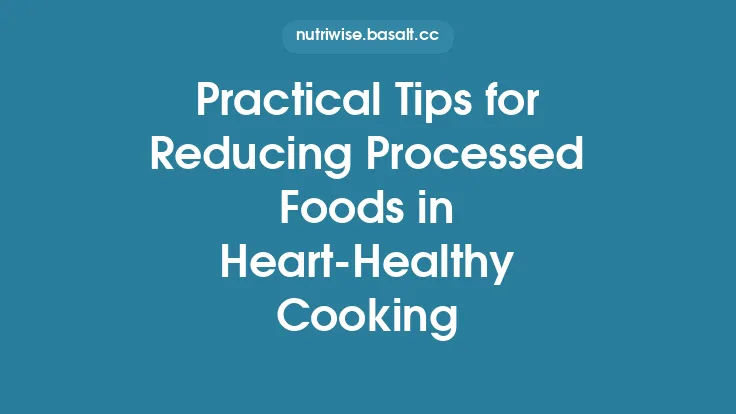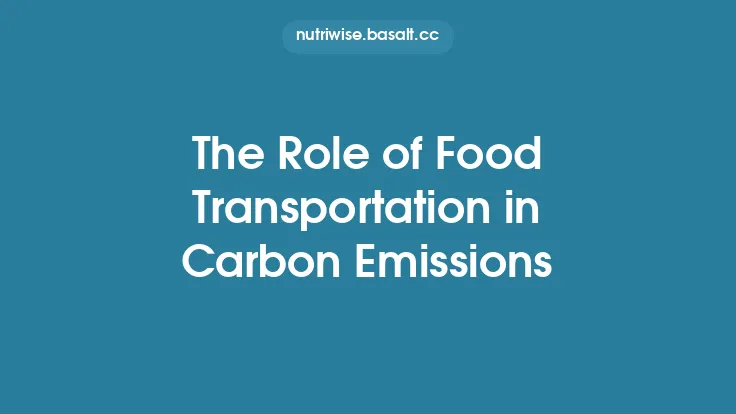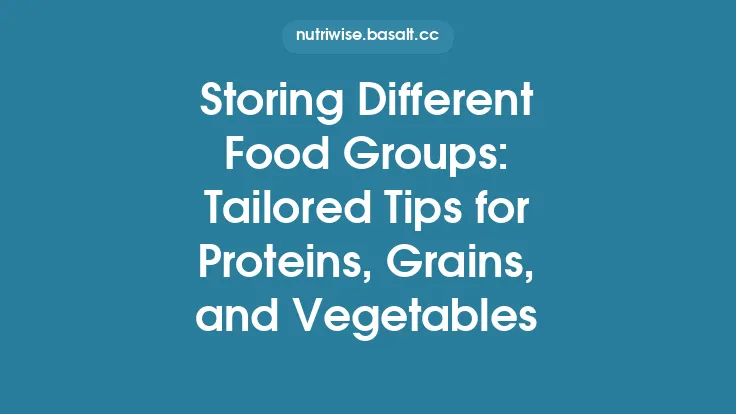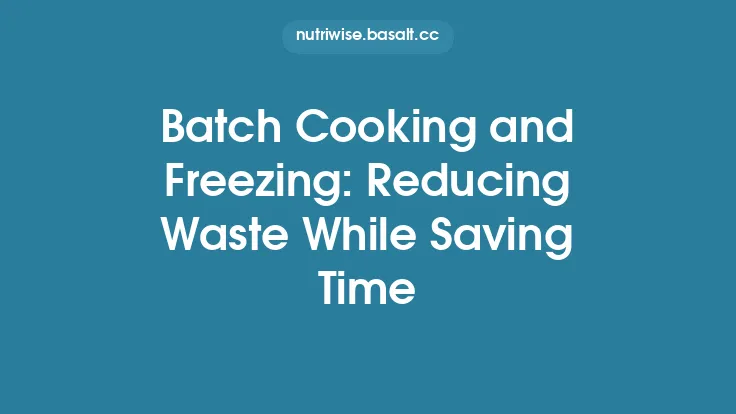Storing food efficiently is one of the most overlooked yet impactful ways to cut carbon emissions in the kitchen. When we keep food fresh longer, we reduce waste, lower the demand for energy‑intensive production of replacements, and minimize the need for frequent trips to the grocery store. Below are practical, science‑backed strategies you can adopt at home to make your food storage and preservation habits more climate‑friendly.
Choose Energy‑Efficient Refrigeration
1. Optimize Temperature Settings
- Refrigerator: Keep the internal temperature between 1 °C and 4 °C (34 °F–39 °F). Anything colder wastes energy without extending shelf life significantly.
- Freezer: Aim for –18 °C (0 °F). Temperatures lower than this provide diminishing returns in preservation while increasing compressor run time.
2. Maintain Proper Airflow
- Avoid over‑packing shelves; air must circulate to keep the compressor from cycling constantly.
- Use the “door shelf” for items you need quickly, as the door is the warmest part of the unit.
3. Keep the Coils Clean
- Dust and grime on condenser coils force the compressor to work harder. Clean them at least twice a year with a vacuum brush.
4. Upgrade to Energy‑Star Models
- Modern compressors, better insulation, and variable‑speed fans can cut electricity use by 30 %–40 % compared with older units. Look for the ENERGY STAR label and consider the unit’s annual kWh rating before purchasing.
Harness the Power of the Freezer
1. Freeze at the Right Time
- Freeze foods while they are still fresh. The longer you wait, the more nutrients degrade, and the more likely the food will spoil before you can freeze it.
2. Use Proper Packaging
- Vacuum Sealing: Removes air, which slows oxidation and freezer burn. It also reduces the volume of the package, allowing you to store more in the same space.
- Freezer‑Safe Bags/Containers: If vacuum sealing isn’t an option, use zip‑top bags and press out as much air as possible. Double‑bagging can add an extra barrier.
3. Portion Control
- Freeze foods in meal‑sized portions. This prevents you from thawing a large batch only to discard leftovers, saving both food and the energy required for reheating.
4. Label and Rotate
- Write the date and contents on each package. Follow a “first‑in, first‑out” system to avoid letting items sit indefinitely, which can lead to quality loss and eventual waste.
Optimize Refrigerator Organization
1. Store Foods in the Right Zones
- Bottom Shelf: Ideal for raw meat, poultry, and fish, as it’s the coldest area and prevents drips onto other foods.
- Middle Shelves: Best for dairy, eggs, and leftovers.
- Crisper Drawers: Designed for produce; adjust humidity settings (high for leafy greens, low for fruits) to extend freshness.
2. Use Transparent Containers
- Clear containers let you see what’s inside at a glance, reducing the chance of forgotten items that spoil.
3. Keep the Door Closed
- The door experiences temperature fluctuations each time it opens. Store condiments and drinks there, but keep perishable items inside the main compartment.
Adopt Low‑Energy Preservation Techniques
1. Fermentation
- Fermenting vegetables (e.g., sauerkraut, kimchi) creates an acidic environment that naturally inhibits spoilage microbes. Fermentation requires only a container, salt, and time—no electricity. The process also adds beneficial probiotics.
2. Dehydration
- Removing moisture dramatically slows microbial growth. While electric dehydrators are common, solar dehydrators or low‑heat oven settings (≤ 60 °C/140 °F) can achieve similar results with minimal energy use.
3. Pickling
- Acidic brines (vinegar, lemon juice) preserve a wide range of foods. Store pickled items in the refrigerator after opening to extend shelf life without additional processing.
4. Canning (Water‑Bath Method)
- For high‑acid foods (tomatoes, fruits), a water‑bath canner uses boiling water to achieve safe preservation. This method consumes less energy than pressure canning and can be done in batches to maximize efficiency.
Leverage Smart Technology
1. Smart Thermostats for Fridges
- Some modern refrigerators integrate Wi‑Fi and can be monitored via smartphone apps. Alerts for door left open or temperature spikes help prevent accidental waste.
2. Energy Monitoring Plugs
- Plug your fridge or freezer into a smart plug that tracks real‑time electricity consumption. Identifying spikes can point to maintenance needs (e.g., a failing seal) that, once fixed, reduce emissions.
3. Inventory Apps
- Use free apps to log what you have, set expiration reminders, and generate shopping lists based on what’s already in stock. This reduces duplicate purchases and the associated production emissions.
Reduce Packaging Waste in Storage
1. Reusable Containers
- Glass jars, stainless‑steel tins, and silicone bags can replace single‑use plastic wrap and bags. They are durable, often dishwasher‑safe, and have a lower lifecycle carbon footprint when used repeatedly.
2. Beeswax Wraps
- These biodegradable wraps can substitute plastic cling film for short‑term storage of cheese, bread, and produce. They are reusable, washable, and compostable at the end of their life.
3. Bulk Buying with Refill Stations
- When possible, purchase staples (grains, nuts, dried beans) in bulk and store them in airtight containers at home. This reduces the carbon impact of individual packaging and often results in less food waste due to better storage practices.
Maintain Your Appliances for Longevity
1. Seal Checks
- Test door seals by closing the door on a piece of paper; it should not slide out easily. Replace worn gaskets promptly to keep cold air in and warm air out.
2. Defrost Regularly
- Manual defrost freezers should be cleared of ice buildup at least once a year. Excess ice forces the compressor to work harder, increasing electricity use.
3. Positioning
- Place refrigerators and freezers away from heat sources (ovens, direct sunlight) and allow at least a few centimeters of clearance behind them for proper ventilation.
Plan for Seasonal Surpluses
1. Harvest Preservation
- When you have a seasonal abundance (e.g., a garden harvest or a farmer’s market surplus), prioritize preservation methods that require little to no electricity—fermentation, drying, or root cellaring.
2. Root Cellaring
- A cool, dark, humid underground space can store root vegetables (potatoes, carrots, beets) for months without any energy input. If a dedicated cellar isn’t available, a well‑insulated basement corner or a purpose‑built insulated box can serve the same function.
Educate and Involve Household Members
1. Shared Responsibility
- Assign simple tasks—like checking expiration dates weekly or rotating freezer stock—to each household member. Collective vigilance reduces the chance of unnoticed spoilage.
2. Visual Cues
- Use color‑coded stickers on containers to indicate “use within 3 days,” “use within 1 week,” etc. This visual system helps everyone quickly identify which items need priority consumption.
Summing Up
By fine‑tuning the way we store and preserve food, we can make a measurable dent in carbon emissions associated with the food system. Energy‑efficient appliances, smart organization, low‑energy preservation methods, and mindful packaging choices together create a holistic approach that not only protects the planet but also saves money and reduces food waste. Implementing even a few of these strategies can transform everyday kitchen habits into powerful climate actions.





